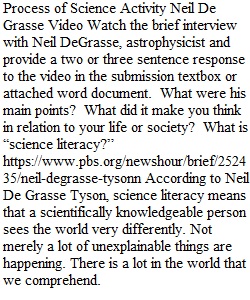


Q Process of Science Activity Neil De Grasse Video Watch the brief interview with Neil DeGrasse, astrophysicist and provide a two or three sentence response to the video in the submission textbox or attached word document. What were his main points? What did it make you think in relation to your life or society? What is “science literacy?” https://www.pbs.org/newshour/brief/252435/neil-degrasse-tysonn Scientific Method Go to https://askabiologist.asu.edu/explore/scientific-method “Using the scientific method to solve mysteries” and read about the scientific method. Then click on “The science detectives training room escape.” Make sure your sound is on and flash player is working to complete the escape challenge. At the end of the challenge, you will be given a code and a report. Enter the code in the submission box in Canvas. Then answer the following questions based on your report: 1. What was the initial observation? 2. What question did you set out to answer? 3. What was your initial hypothesis? 4. Did you formulate a new hypothesis after testing the first one? 5. How did you do an experiment? 6. What was the conclusion? 7. Let’s say you changed the batteries and the switch and then turned the flashlight on. What is the problem with this experiment? Evaluating Web Information The ability to critically evaluate the validity of information is an important skill. In this activity, you will choose a topic related to biology and run a Google search. Click on the first two websites in your search results and answer the following for each: 1. What is the name of the webpage? 2. When was the information posted and/or last updated? 3. Who is the author and what are their qualifications? 4. Can you contact the author? 5. What is the purpose of the webpage? Are the authors biased? Are they trying to convince you of something? 6. What is the address extension? .com (usually a business), .org (non-profit), .edu (educational institution, .gov (government) 7. Do you think this a reliable source of information? Why or why not? The FCC library has a “CRAAP” sheet for critically evaluating websites that may help (link below). https://www.fresnocitycollege.edu/uploaded-files/documents/academics/eval_websites.pdf How Scientists Communicate Of course, the internet is a good place to start gathering information on a topic. But it is important to locate the original source of scientific information. Scientists publish their findings in peer-reviewed, scientific journals. They are reviewed by other experts in the field (their peers) for validity prior to being published. Scientific journal articles have a specific format. They will have a title, authors, authors affiliations, abstract, introduction, materials and methods, results, and conclusion section. For more information on the parts of a scientific article, you can visit Anatomy of an Article As a student, you have access to thousands of peer-reviewed, scientific journal articles. Use the FCC library database (Ebsco host, also called Academic Search Premiere) to locate one scientific journal article on the topic you chose in the webpage activity. You will have to login from off campus. https://fresnocitycollege.libguides.com/az.php Check the box for “scholarly, peer-reviewed” when conducting your search. Once you locate an article, make sure it has all of the sections listed above. Then enter the title of the article, name of the journal in which it was published, and date of publication below. Then answer the following questions. You do not need to attach the article. 1. Title, Journal name, date of publication: 2. Look at the authors’ affiliations (where they work). What type of institutions are these? 3. What question were they trying to answer? 4. What was the general design of the experiment? Keep your answer brief (1-2 sentences) 5. List one interesting finding. 6. How does the title of the article compare to an article you might find in a magazine or newspaper? The difference is due to the intended audience and authors. A newspaper article is written for the general public by a journalist. The journalist has read and interpreted the original journal article. A scientific journal article is written by the scientist who conducted the study for other scientists in the field. Scientific, peer-reviewed journal articles are the most reliable source of scientific information. The findings in these articles represent a small piece of evidence for a greater understanding of the natural world. It is important to remember that science is a way of thinking and knowing. And most of all, science aims to collect evidence to gain a better understanding of the world around us.
View Related Questions